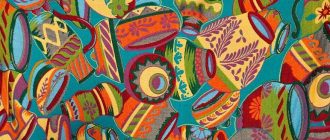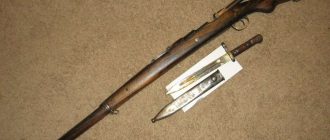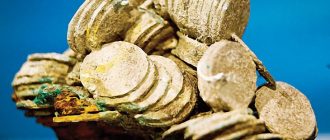At various intervals since collecting American antiques became the fashionable fad in this young country of ours, there have been revivals of interest in Bohemian glass. Upon hearing the name, the average collector immediately conjures up a vision of a ruby-red glass with grapevines and bunches of grapes etched or engraved in a frosted effect against the red background. Various sorts of ruby-red glass were made at our own factories but since the earliest ware was all imported, the trade and the public gave it the generic title of Bohemian glass.
As a matter of fact, glass making was an important industry in Bohemia for several centuries. Many kinds and types of glass were produced, both blown and pressed. Bohemian cut glass was famous the world over. The varieties the average collector knows best today are those illustrated in this book. During the 1870′s and 1880′s, such huge shipments of all their specialties, including engraved, cut, gilded, painted, etc., came into this country, that quantities of it survived for us to collect years later. Many of the articles shipped in were of an ornamental character, and did not suffer the hard usage of tableware. To judge between the old and the new is largely a matter of appreciating quality, workmanship, and preservation.
Twenty-five or thirty years ago Bohemian glass again became very popular, particularly the ruby-red pieces. The vogue was so great that the supply was reduced until it became quite scarce. Naturally, the finest pieces available went into collectors’ cabinets, as permanent tenants. As was to be expected, a flood of reproductions came from Bohemia, now Czechoslovakia. Some were quite beautiful and others very crude. Commercialism knows no geographical boundaries.
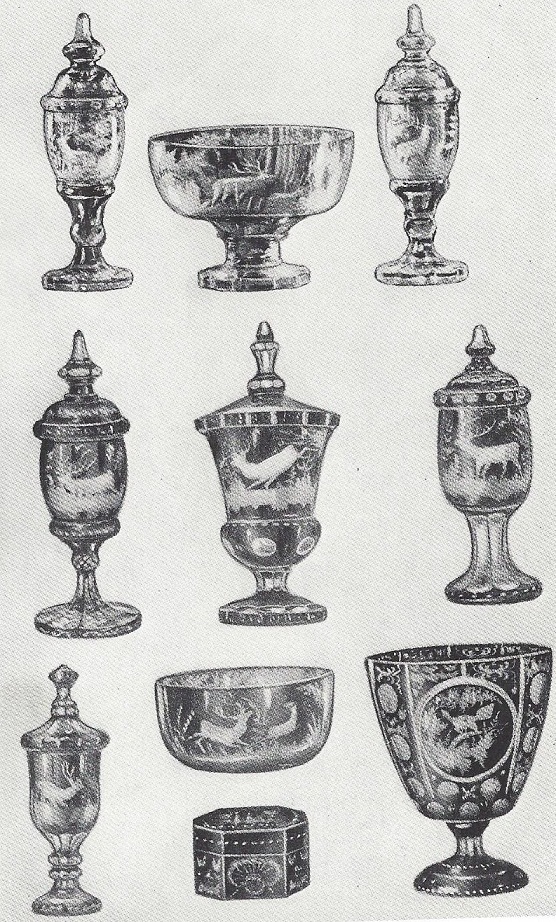
One of the earliest reproductions brought to my notice was the little pinch-bottle cordial set, shown in the lower right-hand corner of Plate 123.
These were displayed in amber as well as in ruby, all with the etched grapevine. About the same time there appeared two different styles of vases, eleven inches high, which were an opaque-red over milk-white, with a design after “Eggermann.” These are illustrated at the top of Plate 124.
Shortly thereafter the ruby glass engraved with the ever-popular stag or hunting scenes, as well as the Vintage or Grapevine patterns, arrived in large quantities. They were decorative and well worth the prices asked by department stores, but no one should think of paying the values set onthem when offered as genuine antiques.
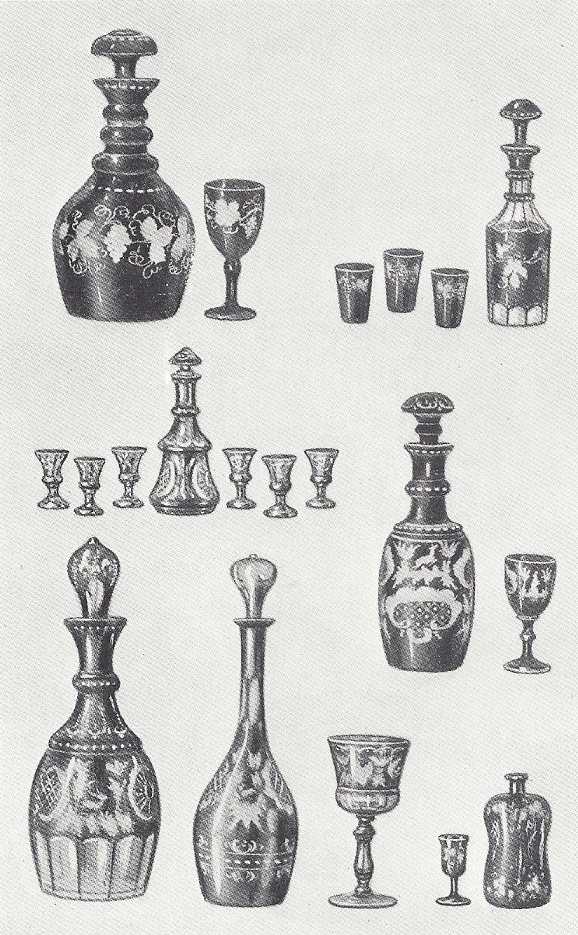
On Plate 122 are shown a number of the finer pieces, engraved with the Stag. At the top of this page is shown a console set which came in sapphire blue; amethyst, green, and ruby. The jar in the center of the page is twelve inches high and was made in blue as well as in ruby.
The one on the left of the center is fourteen inches high and may be found in blue, amber, green, and ruby. The one on the right is ten inches high and is obtainable in green, blue, and ruby. In the lower corner is one eleven inches high which was sold in blue, amber, and ruby.
It will be noted that these are all fairly large pieces that create handsome color effects in any home. The bowl in the center of the page is greatly reduced in size in the picture.
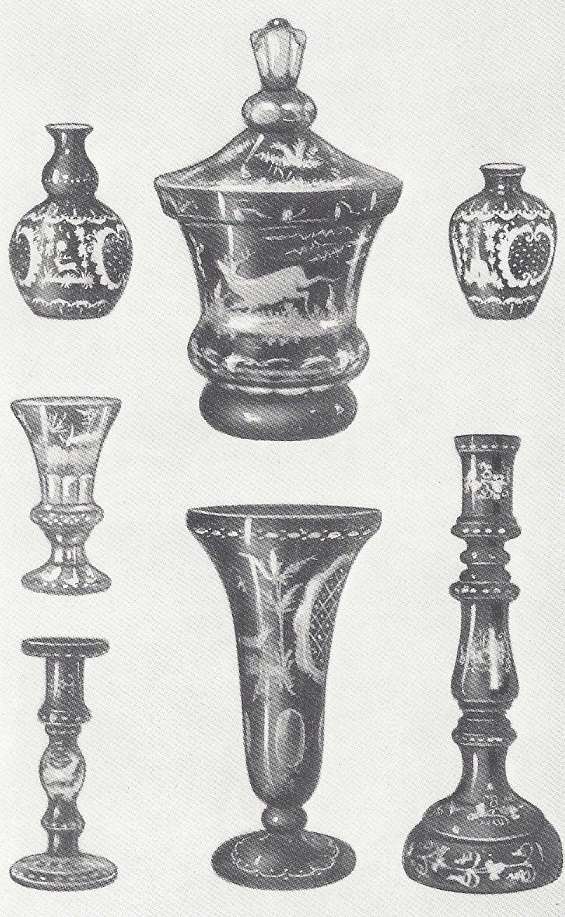
The covered jar and large vase in the center of Plate 124 were still being made and sold in 1938. The jar is eight inches high and comes in crystal, in blue, and in ruby. The vase is seven and one-half inches high and is found in blue, and in ruby.
The large candlestick pictured on the same page is eleven inches high. This was still on sale during the 1930′s though it was carried over a number of years. There was a similar pair of candlesticks that were brought to me about twenty-five years ago, by a newly married young chap who said he had purchased them in an antique shop in New York State, where he was told they had been bought by the dealer from a very old lady who wept because she had to part with family heirlooms, but she had to have coal. It was a familiar story.
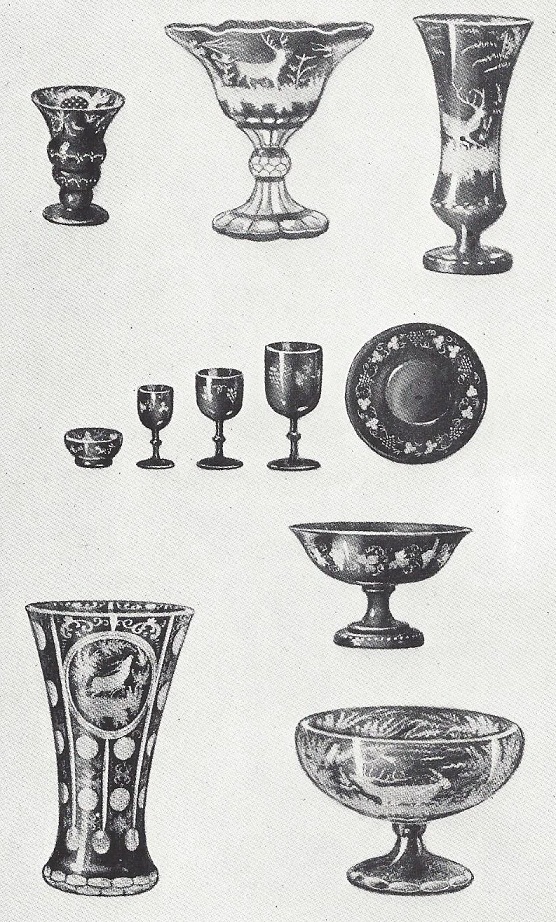
The wine set at the left side of the upper part of Plate 123 is from the old line which came to this country years ago, in ruby, green, and blue. The liqueur set next to it was made in blue and ruby only. The liqueur set below it, on the right, came in four colors-blue, ruby, amber, and green.
Next to it, in the center, is another liqueur set, also from the older line, in amber and ruby and is engraved in typical Bohemian style, which is attractive enough to make it popular.
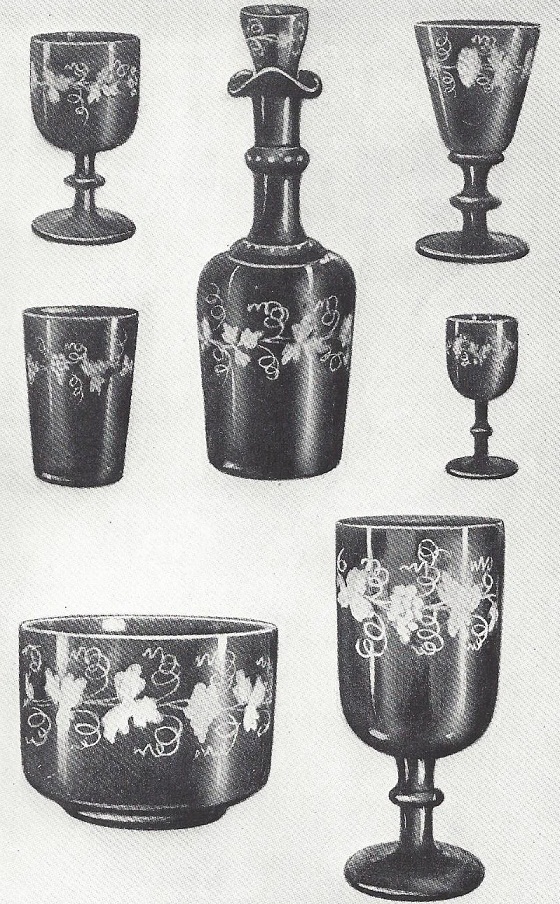
The two large decanters and the wine glass shown in the lower pan of Plate 123 are fine examples of the style of glass that was imported about twenty-five years ago by a New York importing firm.
The set included a large service plate, nine inches in diameter; a salad plate in a seven-inch size, goblets, wines, cordials, salts, and finger bowls in two sizes. A large line is still carried today, as shown on Plate 126. It will be noted that the wines are offered with the round bowl, as well as with the cylindrical shape.
This present-day work is crude, and in no way compares with that workmanship for which there was an active market when pocket-books were fatter. The compotes on Plate 125 are examples of that finer workmanship. The one at the top of the page comes in ruby, amber, and blue.
On Plate 127 are shown three cordial sets. The one at the top of the page is by far the most attractive. It sold at only $6.00 per set of decanter and six glasses. The other two sets were cheaply made for wide distribution and cost $3.75 per set.
The importers of most of this new red Bohemian glass frankly sell it as new. Their business is largely with department stores, gift shops and ceramic studios. If any of these wares find a way into antique shops and are there sold as “genuine antiques,” the importers should not be blamed, even though some jobbers in advertisements stress the close resemblance to old models. The major differences between the old and the new Bohemian glass are found in the quality of the workmanship and of the glass itself and in the absence of the usual recognizable signs of age.
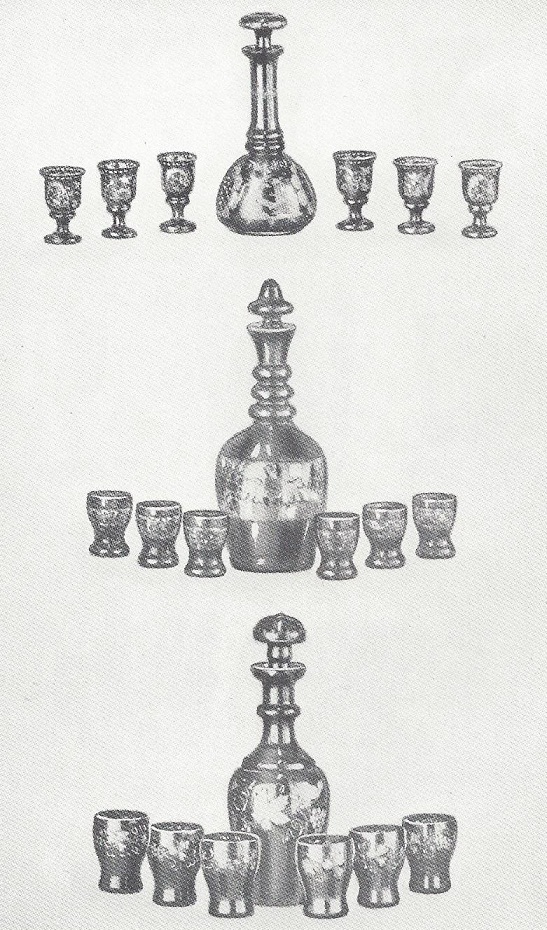
So much overlay glass has been imported from Czechoslovakia that some collectors ignore the fact that it was also made in other countries. Many of our own factories produced an excellent quality of this popular glass, but never to the extent of the European sources. Importing houses today have very beautiful “case glass” pieces, such as those illustrated on Plate 147.
This glass is made in two parts. After a piece is completed, it is cut and, in some cases, enameled in floral designs in colors or covered with a delicate tracery in gold. “Lusters,” vases and covered jars were favorites. In overlay glass, we made chiefly lamps and utilitarian items and seldom attempted to match the elaborate pieces, so many of which came from Czechoslovakia. European countries concentrated largely on ornamental and decorative objects.

